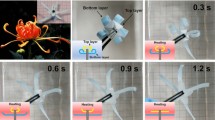Abstract
Light-activated shape-memory materials can return to the originally printed or manufactured shape in temperatures higher than their glass transition temperatures. This effect is widely applicable in the field of biomedicine, biology and others. In this research we are focusing on new materials for light-activated 4D printing—the focus is placed on biocompatible CuS nanoparticle /polyurethane composite for light conversion to heat that can be used as a filament for 3D printing. The synthesis of the composite and nanoparticles, as well as the physical properties of the material are described, and the shape-memory effect is tested for different concentrations of the nanoparticle filler. The best results were found to be for 0.5% CuS/PU composite that reached the unfolding time of 63 s under Xe lamp irradiation.







Similar content being viewed by others
References
Tappa K, Jammalamadaka U (2017) Nocel biomaterials used in medical 3D printing techniques. J Funct Biomater 9(1). https://doi.org/10.3390/jfb9010017
Ashammakhi N, Ahadian S, Xu C, Montazerian H, Ko H, Nasiri R, Barros N, Khademhosseini A (2019) Bioinks and bioprinting technologies to make heterogeneous and biomimetic tissue constructs. Materials Today Bio, 1. https://doi.org/10.1016/j.mtbio.2019.100008
Ying Y, Choong C, Maleksaeedi S, Eng H, Jun WJ, Sua P (2017) 4D printing of high performance shape memory polymer using stereolithography. Mater Des 126:219–225
Pilate F, Mincheva R, De Winter J, Gerbaux P, Wu L, Todd R, Raquez J, Dubois F (2014) Design of multi stimuli-responsive shape-memory polymer materials by reactive extrusion. Chem Mater 26(20):5860–5867
Zolfagharian A, Kaynak A, Khoo SY, Kouzani A (2018) Pattern-driven 4D printing. Sens Actuators, A 274:231–243. https://doi.org/10.1016/j.sna.2018.03.034
Bodaghi M, Noroozi R, Zolfagharian A, Fotouhi M, Norouzi S (2019) 4D Printing Self-Morphing Structures. Materials 12:1353
Zhou Y, Huang WM (2015) Shape memory effect in polymeric materials: mechanisms and optimization. Procedia IUTAM 12:83–92. https://doi.org/10.1016/j.piutam.2014.12.010
Maitland DJ, Wilson T, Metzger M, Schumann DL (2002) Laser-activated shape memory polymer microactuators for treating stroke. Biomedical nanotechnology architectures and applications 4626:394–402. https://doi.org/10.1117/12.472105
Muschenborn AD, Hearon K, Volk BL, Conway JW, Maitland DJ (2014) Feasibility of crosslinked acrylic shape memory polymer for a thrombectomy device. Smart Mater Res 1–12. https://doi.org/10.1155/2014/971087
Jahangiri M, Kalajahi AE, Rezaei M et al (2019) Shape memory hydroxypropyl cellulose-g-poly (ε-caprolactone) networks with controlled drug release capabilities. J Polym Res 26:136. https://doi.org/10.1007/s10965-019-1798-1
Wu J, Mu C, Yang J (2020) Reversible visible/near-infrared light responsive thin films based on indium tin oxide nanocrystals and polymer. Sci Rep 10:12808. https://doi.org/10.1038/s41598-020-69110-y
Jin TK, Kim BK, Kim EY, Sun HK, Han MJ (2013) Synthesis and properties of near IR induced self-healable polyurethane/graphene nanocomposites Eur. Polym J 49:3889–3896
Lai S, Guo G, Xie Y et al (2020) A novel multi-triggered natural rubber (NR)/beeswax (BW)/carbon nanotube (CNT) shape memory bio-nanocomposite. J Polym Res 27:283. https://doi.org/10.1007/s10965-020-02256-5
Shou Q, Uto K, Iwanaga M, Ebara M, Aoyagi T (2014) Near-infrared light-responsive shape-memory poly(ɛ-caprolactone) films that actuate in physiological temperature range. Polym J 46(8):492–498. https://doi.org/10.1038/pj.2014.48
Bai Y, Zhang J, Chen X (2018) A thermal-, water- and near-infrared light-induced shape memory composite based on polyvinyl alcohol and polyaniline fibers. ACS Appl Mater Interfaces 10(16):14017–14025. https://doi.org/10.1021/acsami.8b01425
Monteavaro LL, Riegel IC, Petzhold CL, Samios D (2005) Thermal stability of soy-based polyurethanes. Polimeros 15(2):151–155. https://doi.org/10.1590/S0104-14282005000200018
Javni I, Petrovic ZS, Guo A, Fuller R (2000) Thermal stability of polyurethanes based on vegetable oils. J Appl Polym Sci 77(8):1723–1734
Peniche C, Zaldivar D, Pazos M, Paz S, Bulay A, Roman JS (1993) Study oh the thermal degradation of poly(N-vinyl-2-pyrrolidone) by thermogravimetry – FTIR. J Appl Polym Sci 50(3):485–493. https://doi.org/10.1002/app.1993.070500312
Salles THC, Lombello CB, d’ Avila MA (2015) Electrospinning of gelatin/poly (vinyl pyrrolidone) blends from water/acetic acid solutions. Mater Res 18(3):509–518. https://doi.org/10.1590/1516-1439.310114
Mattos RI (2011) Estudo de condutores protônicos a base de macromoléculas naturais, Interunidades em Ciência e Engenharia de Materiais. São Carlos. https://doi.org/10.11606/T.88.2011.tde-25092011-171004
Acknowledgements
This research was conducted as a part of project “Light activated 4D printed materials” of the Baltic-German University Liaison Office is supported by the German Academic Exchange Service (DAAD) with funds from the Foreign Office of the Federal Republic Germany. We are thankful to Latvian State Institute of Wood Chemistry, where the DSC measurements were made by Dr. Chem Dzintra Vilsone. Institute of Solid State Physics, University of Latvia as the Center of Excellence has received funding from the European Union's Horizon 2020 Framework Programme H2020-WIDESPREAD-01-2016-2017-TeamingPhase2 under grant agreement No. 739508, project CAMART2.
Author information
Authors and Affiliations
Corresponding author
Additional information
Publisher’s Note
Springer Nature remains neutral with regard to jurisdictional claims in published maps and institutional affiliations.
Rights and permissions
About this article
Cite this article
Vitola, V., Bite, I., Apsite, I. et al. CuS/polyurethane composite appropriate for 4D printing. J Polym Res 28, 13 (2021). https://doi.org/10.1007/s10965-020-02375-z
Received:
Accepted:
Published:
DOI: https://doi.org/10.1007/s10965-020-02375-z




